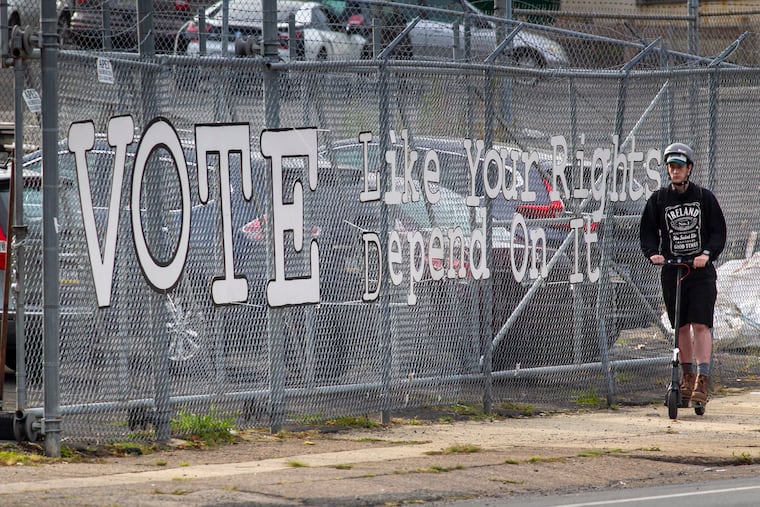Philadelphia’s voter turnout is down. That’s bad for democracy. | Editorial
Open primaries, automatic voter registration, and improved access to mail-in voting are some steps that could reverse the trend.

Increased voter turnout helped Democrats sweep the statewide races for governor and the U.S. Senate in Pennsylvania this year. While turnout increased across the commonwealth compared with the 2018 midterms, it dropped in Philadelphia.
In fact, turnout decreased the most of any county in the state.
The sagging performance is part of a disturbing trend in Philly: This is the third consecutive election where Philadelphia’s share of the state vote declined.
That’s a troubling harbinger not only for Democrats but for America. Philadelphia voters powered Joe Biden’s victory in Pennsylvania, helping protect the country from a ruinous second term under the twice-impeached, insurrection-inciting Donald Trump.
Philadelphia has long been the engine for Democratic votes in the Keystone State. As goes Philadelphia, so goes Pennsylvania. And so goes democracy. Strong Democratic turnout is vital as long as Republicans keep putting forward election deniers and supporting voter suppression efforts.
That’s why it was welcome news to see the Lenfest Institute for Journalism invest $1.5 million as part of its “Every Voice, Every Vote” initiative to bolster voter engagement and news coverage during the 2023 election in Philadelphia.
» READ MORE: The old fight against Trump begins anew | Editorial
The Lenfest Institute owns The Inquirer, so we have an obvious dog in the fight. Then again, promoting a healthy democracy and vibrant public service journalism is at the core of what we do. The two go hand in hand, as studies show the decline in newspapers has led to a less informed electorate.
The Jan. 6, 2021, riot at the U.S. Capitol was a wake-up call for many voters. Trump and his cronies tried to orchestrate a coup to prevent the peaceful transfer of power. Scores of election deniers who ran for office this year, including Pennsylvania Republican gubernatorial candidate Doug Mastriano, further alarmed voters who understood that democracy was on the line.
That threat has not gone away. The conservative-leaning U.S. Supreme Court has been slowly chipping away at voting rights established in the wake of the civil rights movement. Meanwhile, Republican-controlled state legislatures have implemented scores of so-called reforms designed to suppress voter turnout, particularly among voters of color.
That is another reason why more outreach and voter education efforts are needed, especially in communities of color. Beyond that, Philadelphia should look for other ways to increase voter turnout.
» READ MORE: How many more convictions before things change in Pa.? | Editorial
Obvious steps include holding open primaries, moving the local election to coincide with the state and federal primaries, automatic voter registration, promoting more mail-in voting, and building on the increase in young voters who came out in 2022. Making Election Day a national holiday or moving it to a Saturday could also increase turnout.
Some of those steps would require state or federal action, but there is a bill pending in Harrisburg that would allow open primaries. That would go a long way toward increasing voter interest and creating more competitive races. It would serve as a corrective to places such as Philadelphia, where the Democratic Party has grown calcified.
In Philadelphia, the number of Democratic voters outnumbers Republicans by a margin of more than 7-1. As such, the Democratic primary essentially determines who will be elected mayor.
An open primary would allow registered Republicans and nonaffiliated voters to have a voice. In the November midterms, more than 800,000 Democrats voted in Philadelphia. More than 264,000 people registered to other parties or nonaffiliated also voted in the city.
Overall, open primaries in Pennsylvania would allow the more than one million independent voters who are largely deciding general elections to take part in the primaries. Indeed, the number of independent voters has been increasing in recent years as many become disgusted with both parties.
Another step would be to move the mayoral and other local elections to coincide with the state and federal midterms. Austin, Texas, and scores of cities in California experienced an increase in voter turnout after moving local elections.
Expanding vote by mail has also helped to increase turnout in Colorado, Oregon, Utah, and Washington.
The American Experiment began in Philadelphia. The city should be leading the way to make sure every voice and every vote counts.